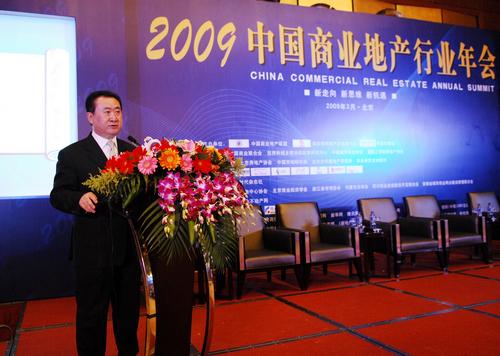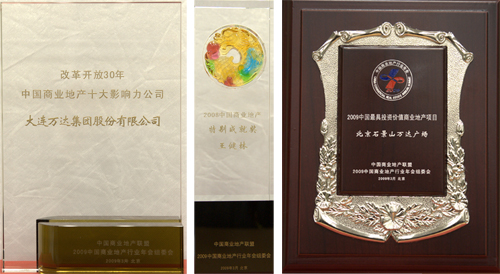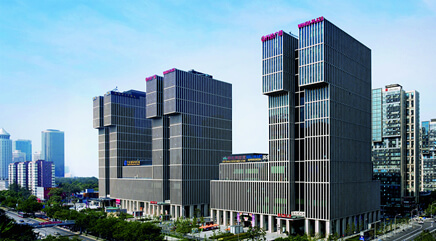Wanda Won Three Commercial Real Estate Awards
23.03.2009The 2009 (6th ) China Commercial Real Estate Annual Forum & Annual Award-Giving Ceremony co-sponsored by China Commercial Real Estate Union, Circulation Industry Promotion Center of the Ministry of Commerce and China times was held at Pullman Beijing Wanda in March 21~22. About 500 representatives from commercial real estate, retail, finance and other industries attended the forum. Chairman Wang Jianlin attended the forum upon innovation and delivered a speech titled “Shopping Center: How to Attract Merchants”.

Chairman Wang Jianlin addressed the 2009 Commercial Real Estate Annual Forum.
Wudan Group won many awards at the annual award-giving ceremony. Chairman Wang Jianlin won the “Special Achievement Award for 2009 China Commercial Real Estate”; Wanda Group was honored as “Ten Most Influential Companies in China Commercial Real Estate Industry in 30-year Reform”; Shijingshan Wanda Plaza was awarded the title of “2009 China Commercial Real Estate Projects with the Most Investment Value”.

Speech of Chairman Wang Jianlin on Attraction of Merchants for Commercial Real Estate
It has been over 8 years since Wanda Group started the commercial real estate business. To date, there are 19 Wanda plazas across the countries, and another 8 will open this year, plus 13 in 2010 additionally. Each Wanda Plaza is a hot place. The collection ratio of rentals and property management fees has exceeded 99% since 2005. There are many factors contributing to success, including our long involvement, big scale, extraction of laws of Chinese commercial real estate development, and unique business modes. Today, I’d like to take this opportunity to talk about a small aspect, and the most important aspect: How to attract merchants for commercial real estate? It is just for your reference.
In merchant attraction for Wanda plazas, we have built up experience in four aspects:
First, inviting brand enterprises. Two types of merchants may be invited. The first is brand enterprises, such as supermarket giants Wal-Mart, Carrefour and Parkson, electrical appliance retailers Suning and Guomei. They are well known to us. The second is less famous small businesses. From the perspective of merchant invitation, brand enterprises offer lower rental than small businesses, but the latter pose higher risks and pay rental less reliably. No problems will occur if business goes well, but troubles will emerge if business runs into difficulty and fails. Therefore, Wanda follows an important principle in merchant invitation: Focusing on brand enterprises and omitting start-ups.
Second, inviting anchor stores and junior anchors. That means allocating a large space to anchor stores. For example, for a 100,000 m2 shopping mall, 50,000 m2 should be allocated to anchor stores. Anchor stores refer to supermarket, department store, household electrical appliance retailer, cinema and skating rink that at least cover several thousand square meters. There is a shopping mall in Taiwan that had a promising start. When it opened, customers driving to it caused traffic jam for hours on the expressway and even resulted in delay of many international flights, for the jammed road links the airport.
However, after a couple of years, that shopping center went painstakingly and nearly failed. I feel that an important cause for its unsuccess lies in the absence of anchor stores. It only housed small and medium stores sized 200~300 m2. Though they pay higher rental, they are very vulnerable to risks. I think small and medium stores have a common feature: eager to share happiness but reluctant to share woe. They may rack their brains to get in at good times, even by bribery. But if any problem occurs in or after the fostering stage, they are likely to close down and retreat, affecting the overall atmosphere of the shopping center. But for anchor stores, they won’t retreat in difficulty, for they spend a lot of money in facilities investment after entering. Such anchor stores are more stable. Therefore, Wanda always arranges the majority of the retail space for anchor stores to stabilize the marketplace and provide a strong influence. The remaining space is then distributed to small and medium stores. Such an approach ensures a stable shopping center from the very beginning, and prevents the center from closing down in major difficulties. It is important experience Wanda draws from failure cases.
Third, diverse business types. There should be a reasonable portfolio of business types offering low cost, low rental and high rental that complement one another in functions. A 100,000 m2 shopping center may want to charge RMB100, RMB200 or even RMB300 for each square meter, i.e. for clothing, jewelry and cosmetics tenants. However, the problem of similarity will occur if the most businesses housed by the center are of such types. They may survive in such prime locations as Wangfujing and Nanjing Road. But survival is a difficulty at less privileged locations. What should we do? Wanda lays out a mandatory rule in merchant invitation, that is, retail businesses cannot exceed 50%, or say stores paying higher rentals can occupy 50% or 60% as maximum. Low-rental businesses should take up one half or even more, such as cinema, skating rink, game club, fitness center and restaurant. These tenants can afford less than RMB50 per square meter on average in Chinese markets. For example, the fitness center has a fixed income each day and cannot afford high rental; As for cinema, Wanda cinemas have good performance in the sector, able to sell RMB600,000 per screen each year, 3.5 times average multiplex cinemas. Even so, the rental for cinemas is very low, just RMB60~70 per square meter a month, or even RMB30~40. But why we make such a choice? Because we recognize in operation and development that only inviting more low-cost and low-rental tenants can assure a stable customer flow and make the center alive. Low-rental tenants always generate high customer flow, such as cinema, Kara-Ok and skating rink paying less rental but attractive to many people, in particular the young. These target customers can bring other high- medium- and low-end customer flows and stabilize operation. If all tenants sell clothing and cosmetics, it is not far away for the center to close down. That’s one of o






